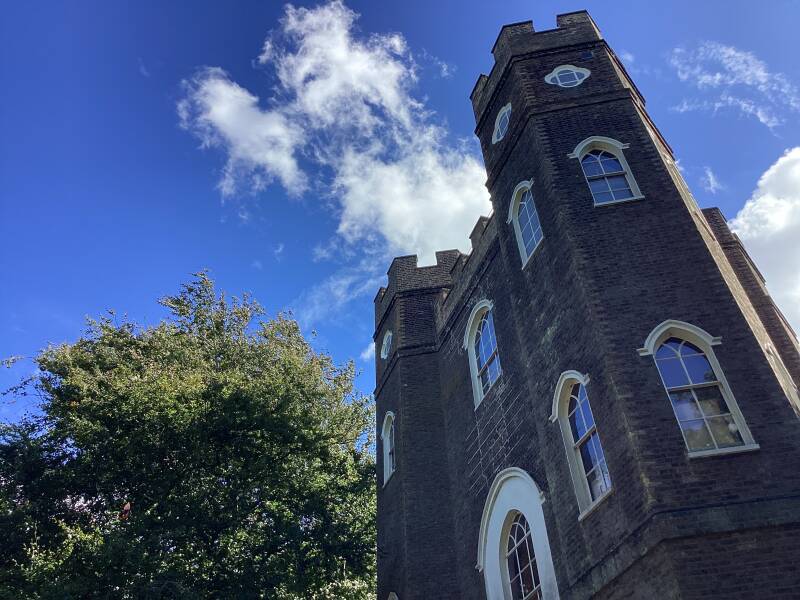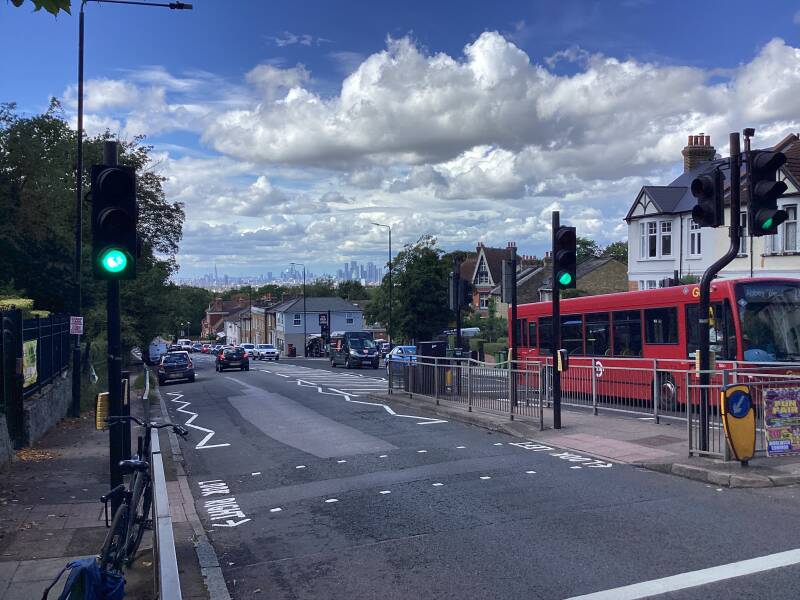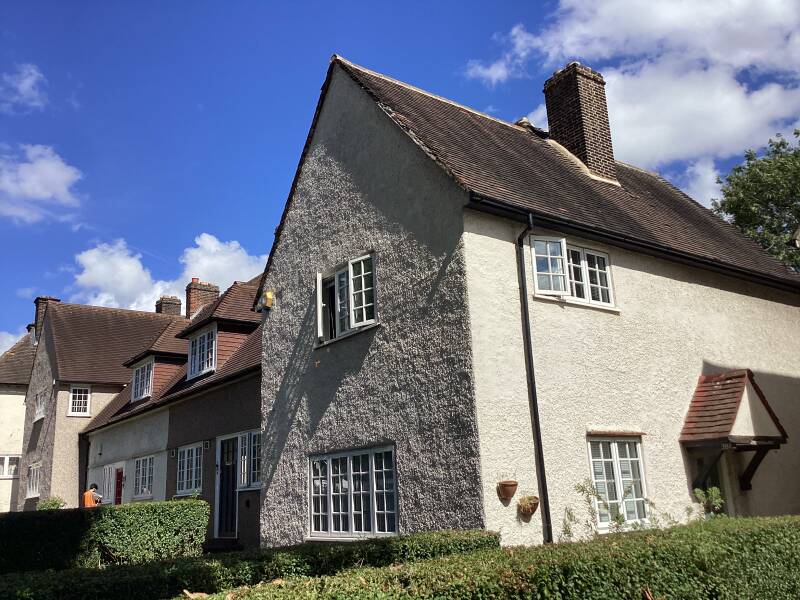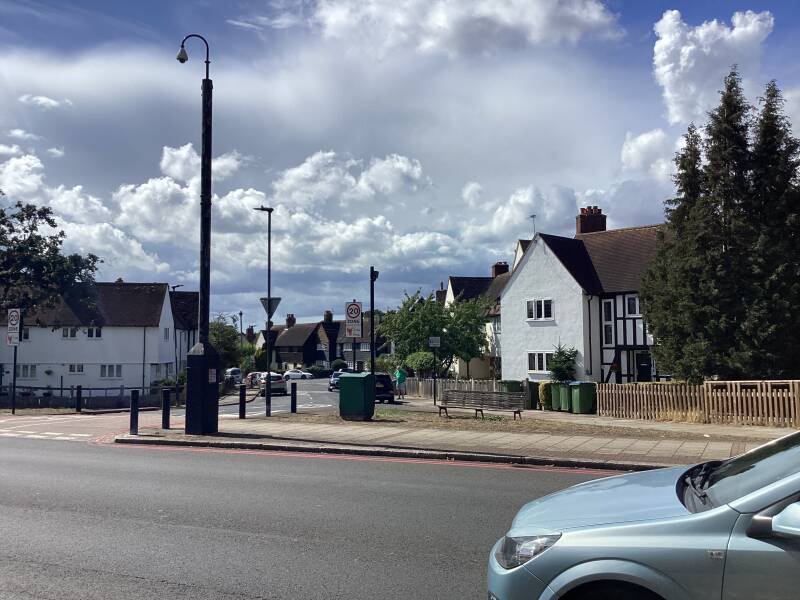Villas Manthorpe Vicarage

WOOLWICH-PLUMSTEAD-SHOOTERS HILL-OXLEAS WOOD- ELTHAM.
Next chapter: ELTHAM PARK- NEW ELTHAM-MOTTINGHAM- LEE- HITHER GREEN
St.Margaret’s Grove
MANDIR: Shree Swaminarayan Temple - Bhuj






Wrottesley Rd
Genesta Road
85–91 Genesta Road
the United Kingdom's only modernist terrace built in the 1930s,[1] designed by the architectural pioneer Berthold Lubetkin with A. V. Pilichowski. The houses were among the first attempts to redesign the traditional English house with the benefits of concrete construction. Completed in 1934, they are listed grade II*.
85–91 Genesta Road was the first domestic project in the U.K. undertaken by Lubetkin. Built in the middle of a 19th-century terrace, the site was previously an orchard,[3] and its principal feature is its height and the dramatic, almost precipitous fall to the north, giving views across the River Thames from the rear of the property. Neighbouring Victorian cottages overcome this site by having steps that lead up to a first floor, relegating the ground level to a basement. Lubetkin, however, placed the entrance on the ground floor, with a spiral staircase leading up to the living room. This arrangement gives full frontage to the living room and provides off-street parking next to the front door.[4]
The bulk of the accommodation is on the first and second floors. The party walls and the intermediate columns are articulated in counterplay with the horizontal concrete window band that projects at living room level. Relieving curves at the entrance and the cyma bedroom balconies are typical characteristics of Lubetkin's work, occurring in other buildings such as Highpoint I.[5]
Cantwell Road
Brent Road
Eglinton Hill


Plum Road
Former FIRE STATION

TUMULUS or BARROW

Mereworth Drive
Bushmoor Crescent
SHREWSBURY PARK district
SHREWSBURY PARK Conservation Area
SHREWSBURY HOUSE


Shrewsbury House was built in 1923, replacing a house of the same name situated further up the hill to the north-east. The earlier Shrewsbury House had been built in 1789 for the Earl of Shrewsbury, a descendant of Bess of Hardwick.
In 1799 the house and grounds came into the ownership of the Prince Regent, later George IV, and his daughter Princess Charlotte stayed there in that year. Subsequently the house went through a series of private ownerships.
SHREWSBURY PARK, the actual park
The house's grounds were leased for a London County Council Open Air School from 1908 and in 1928 the LCC purchased part of the grounds for public open space, which became Shrewsbury Park.
During World War II the park was the site of a barrage balloon, part of the Air Ministry's Field Scheme Nosecap for the defence of London; during the Battle of Britain it was manned by 901 County of London Barrage Balloon Squadron,[2] based at nearby
It takes its name from the earls of Shrewsbury; the land was formerly part of the Shrewsbury estates
ELMSHURST COTTAGE



SUBURBAN HOUSES


A 1930s Wimpey’s Estate




George Wimpey was founded by George Wimpey and Walter Tomes as a stone-working partnership in 1880 in Hammersmith.[3] Tomes would later sell his portion of the business in 1893.[7]
George Wimpey died in 1913 at the age of 58, with his family putting the business up for sale in 1919. Godfrey Mitchell bought the firm and decided to retain the Wimpey name.[3] George Wimpey completed its first residential development, the Greenford Park Estate, in 1928.[3]
In the 1970s, George Wimpey became the United Kingdom's largest private housebuilder, selling 106,440 homes in the decade, and in the 1980s, George Wimpey began to reinforce Wimpey Homes as a brand, focusing on compact housing.[8]
In March 1996, George Wimpey acquired McLean Homes, a business founded in 1934 by John McLean, from Tarmac.[9] In August 2001, the business acquired McAlpine Homes from Alfred McAlpine in a £463 million deal,[10] and in October 2002, George Wimpey went on to acquire Laing Homes, a premium housebuilder, from John Laing for £295 million.
Foxcroft Road
Occupation Road


Modern Communications

What about the ADMIRALTY SHUTTER TELEGRAPH?
Almost the very top of the hill. This is WATLING STREET
The name Shooters Hill is thought to takes its name from the practice of archery there during the Middle Ages. The area had a reputation as a haunt for highwaymen and was infamous as a site of gibbets of executed criminals
Shooter's Hill also gives its name to the road which passes through east to west, part of the A207 road, the A2 road and Watling Street.
THE BELL P.H
WATER TOWER

OXLEAS WOODLANDS









JACKWOOD HOUSE GARDENS



Fresh eggs!


ROSE COTTAGE

Former stables of CASTLE WOOD HOUSE
SEVERNDROG CASTLE




CASTLE WOOD ROSE GARDEN. Site of CASTLE WOOD HOUSE



SHOOTERS HILL (road)



CHRISTCHURCH, SHOOTERS HILL
MEMORIAL
YPRES MILE POST
THE RED LION P.H
WOOLWICH-PLUMSTEAD-SHOOTERS HILL-OXLEAS WOOD- ELTHAM PARK-NEW ELTHAM-MOTTINGHAM-LEE-HITHER GREEN………
ELTHAM COMMON
The ARSENAL’s PROGRESS ESTATE

Two architects stood in an Eltham field at the end of January 1915 checking the natural features on maps they had brought from London.
Their mission was to note the trees, ditches and rights of way across some 96 acres of farmland lying on both sides of Wall Hall Road which was to be developed for housing. This was to be no ordinary estate. Its construction was a direct result of the assassination of the Archduke Franz Ferdinand of Austria at Sarajevo on June 28 1914 which heralded the start of the First World War.
The Royal Arsenal at Woolwich was a foremost national establishment for the manufacture of armaments and its production would be greatly increased to service the needs of our forces. The phrase ‘Woolwich booms in wartime’ was never more apposite and the top brass at the Arsenal were concerned that there was not enough labour available locally to make the munitions. Desperate measures were needed to provide more housing. The officials at the Arsenal did not feel able to address the situation so asked His Majesty’s Office of Works to supply the solution.
Frank Baines, their chief architect, was given the task of designing an estate of 1200 houses. The nearest available level site to Woolwich was at Well Hall on land owned by the Page estate of Mr Polhill Turner.
Well Hall Road




STEPHEN LAWRENCE MEMORIAL



WOOLWICH-PLUMSTEAD-SHOOTERS HILL-OXLEAS WOOD- ELTHAM PARK-NEW ELTHAM-MOTTINGHAM-LEE-HITHER mGREEN………
Next chapter: ELTHAM PARK
NEW ELTHAM MOTTINGHAM LEE HITHER GREEN
